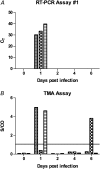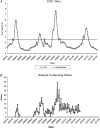Sensitive detection assays for influenza RNA do not reveal viremia in US blood donors
- PMID: 22293429
- PMCID: PMC3282565
- DOI: 10.1093/infdis/jir863
Sensitive detection assays for influenza RNA do not reveal viremia in US blood donors
Abstract
Background: There have been anecdotal reports of influenza viremia since the 1960s. We present an assessment of the prevalence of seasonal and 2009 H1N1 influenza viremia (via RNA testing) in blood donor populations using multiple sensitive detection assays.
Methods: Several influenza RNA amplification assays, including transcription-mediated amplification (TMA) and 2 reverse-transcription polymerase chain reaction (RT-PCR) assays, were evaluated and used to test donor samples. Retrospective samples from 478 subjects drawn at sites with high influenza activity were tested. Prospective samples were collected from 1004 blood donors who called their donation center within 3 days of donation complaining of influenza-like illness (ILI). The plasma collected on the day of donation for these subjects was tested.
Results: Of the repository samples, 2 of 478 plasma samples were initially reactive but not repeat reactive by influenza TMA. Of blood donors reporting ILI symptoms postdonation, 1 of 1004 samples was TMA initially reactive but not repeat reactive; all samples were nonreactive by RT-PCR testing.
Conclusions: Targeting blood donor populations most likely to have influenza infection, we failed to detect influenza RNA in 1482 donor samples, with most tested by 3 different RNA assays. Seasonal influenza does not appear to pose a significant contamination threat to the blood supply.
Figures




Comment in
-
How can the blood transfusion medicine community contribute to public health in tough economic times?J Infect Dis. 2012 Mar 15;205(6):867-9. doi: 10.1093/infdis/jir866. Epub 2012 Jan 31. J Infect Dis. 2012. PMID: 22293430 No abstract available.
References
-
- Yu H, Shu Y, Hu S, et al. The first confirmed human case of avian influenza A (H5N1) in Mainland China. Lancet. 2006;367:84. - PubMed
-
- Tran TH, Nguyen TL, Nguyen TD, et al. Avian influenza A (H5N1) in 10 patients in Vietnam. N Engl J Med. 2004;350:1179–88. - PubMed
-
- Outbreak news. Avian influenza, Indonesia–update. Wkly Epidemiol Rec. 2006;81:233. - PubMed
-
- Ungchusak K, Auewarakul P, Dowell SF, et al. Probable person-to-person transmission of avian influenza A (H5N1) N Engl J Med. 2005;352:333–40. - PubMed
-
- Yuen KY, Chan PK, Peiris M, et al. Clinical features and rapid viral diagnosis of human disease associated with avian influenza A H5N1 virus. Lancet. 1998;351:467–71. - PubMed
Publication types
MeSH terms
Substances
Grants and funding
LinkOut - more resources
Full Text Sources
Medical

